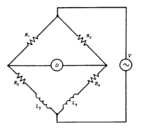c110
Newbie level 3

Hi
I need the ideal solution for
1.
The ac bridge of figure nulls with R1= 1kohm
R2 = 2kohm , R3 = 100 ohm , L3 = 250 mH .
a-find value of R4 and L4
b.if circuit excited by 5-v,1 Khz oscillator , find the offset voltage for L4 = 510 mH.
c.what are the amplitudes of in-phase and quadrature(90 degree) components of offset voltage ?
2.A sensor varies from 1 : 5 kohm , use this in an op Amp circuit to provide voltage varying from 0 to 8 v as the resistance changes .
really I need help
Thank you very much
I need the ideal solution for
1.

The ac bridge of figure nulls with R1= 1kohm
R2 = 2kohm , R3 = 100 ohm , L3 = 250 mH .
a-find value of R4 and L4
b.if circuit excited by 5-v,1 Khz oscillator , find the offset voltage for L4 = 510 mH.
c.what are the amplitudes of in-phase and quadrature(90 degree) components of offset voltage ?
2.A sensor varies from 1 : 5 kohm , use this in an op Amp circuit to provide voltage varying from 0 to 8 v as the resistance changes .
really I need help
Thank you very much


